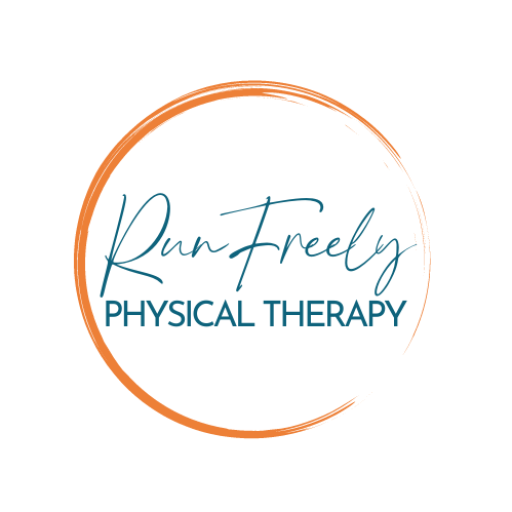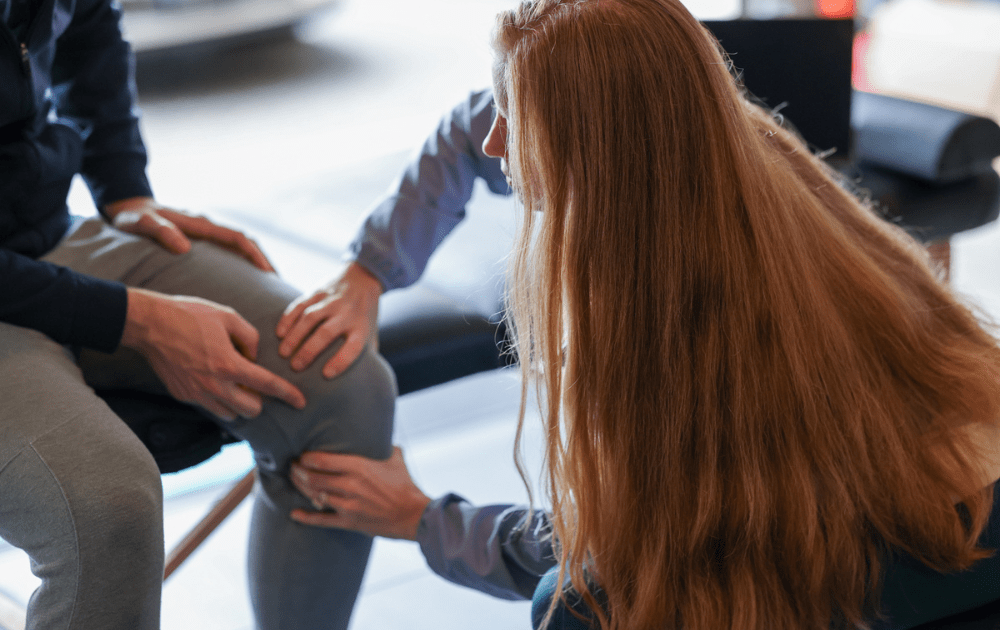Chances are, if you are a runner, you have probably heard of Runner’s Knee. Maybe you have experienced it yourself, know of someone who has dealt with it or perhaps you are just fearful of this sidelining all of your hard work and training.
The knee is the most common body part for runners to injure with around 60% of these injuries being Runner’s Knee, also known as Patella Femoral Pain Syndrome (PFPS).
First, Runner’s Knee, or PFPS, is an umbrella term. It is a name that runners use to indicate they have pain in the front of their knee but that name does not really explain why someone is feeling this pain. I want to go into that more. But first, I think is important to highlight other issues of the knee that can cause pain to be felt on or around the front of this joint.
Sources of pain on the front of the knee of runners:
- Runner’s Knee/ Patellar Femoral Pain Syndrome
- Quadriceps or patellar tendinopathy
- IT Band (usually felt on the outside but can radiate to the front of your knee)
- Degenerative changes/arthritis under the patella, which is your kneecap
- Bone stress injury/stress fracture of bones around the knee
If you are experiencing pain, as you read through this list, you might be wondering, “*How do I know what I have?*”
I highlight this because you can’t always assume that you have something or a certain diagnosis just because of where you are feeling the pain.
This is where I suggest working with a specialized Physical Therapist, such as myself, so that you can discuss your training, and symptoms, and go through an assessment to more accurately diagnose what is going on.
Now, for the sake of this article. Let’s assume you have Runner’s Knee.
What are common signs of Runner’s Knee?
- Pain directly in front of the knee or around the kneecap
- Tenderness when you palpate around the kneecap
- Pain worsens during the run
- Pain with squatting and climbing stairs
- You may have been told that your patella does not track appropriately, or there is “mal-tracking”
- Ruling out other diagnoses is important!
What causes Runner’s Knee?
The usual culprit is an overall decrease in load tolerance of the surrounding muscles, tendons, and joint structures. Symptoms can be provoked by inconsistent training or training that progresses too quickly in terms of volume or intensity. Or running without adequate rest and recovery days.
Simply put, those tissues; muscles, tendons, bones, and joint structures just aren’t ready to handle the load you place on them. Too much, too soon, too quickly can aggravate these tissues and then you have an issue with your tissue!
Other factors include:
- Female bodies are more likely to experience this than male bodies
- Weaker quads
- Weaker hips into abduction, extension, and external rotation
- Abnormal running mechanics
And of course, all of these factors together add up to worsening symptoms.
Weak hips and quads can result in poor alignment of your lower body while running, causing asymmetrical loading, aggravating tissues, and eventually all worsening with an increase in training without addressing the root of the problem.
But our bodies are so strong and resilient. They can overcome this and come back stronger! Our bodies just need specific, individualized guidance and corrections.
After reading all of that, does this sound like something you are experiencing? If it does, you are probably wondering what to do.
What to do?
Well, unfortunately, a lot of runners end up taking a break from running, from a few days to a few weeks. And yes, sometimes that will help resolve your pain. But as soon as you get back to running after that time off, the symptoms usually return. ***Cue the frustration and depression that come along with an injured runner.***
With rest, the pain will reduce or resolve because you are no longer stressing the irritated structures. But with rest, you are not addressing the issues that caused the pain to start with *(think back to what we just listed in the above “causes” section).*
The next step is to ask for advice online and try out what you read. These may be some recommended stretches, strengthening exercises, and maybe different types of taping or bracing. Maybe they will help, maybe they won’t.
What I hope becomes more of the initial response to injured runners, is deciding to work with a healthcare professional that is well-trained and specialized in helping runners. This should be someone who can appropriately assess, diagnose, and help you rehab back to full, healthy, and happy running. We are all unique in our presentations and there is no one size fits all approach.
***I could be treating 5 different runners, all with Runner’s Knee and all 5 rehab plans can all look different.***
So right now, I am showing up here to educate you, on everything mentioned above; what is Runner’s Knee, its common symptoms, and causes. But when it comes to what to do, my ultimate advice is to see someone who can listen to you, assess, diagnose, and come up with the individual plan you need.
Yes, I do that, I do that in person locally but I also help people virtually. If not me, then research in your local area for someone who specializes in runners. Find someone who will look at your training plan, really listen to your symptoms, and assess you. They should assess your whole body, not just at your knee, watch you run (via you sending a video or watching in person), set goals with you, and progress you over time.
*Please message me if you have questions about what you should be asking for or looking for when trying to find a provider to help you.*
Here are my top 6 exercises for Runner’s Knee:
Since you made it this far, I will leave you with a handful of exercises that I may use throughout someone’s rehab plan if they are experiencing pain in the front of their knee.
We will move from mobility to strength, and then to stability.
**Please excuse any dogs barking in the background!! ????
Mobility Exercises
Calf Eccentrics
If you have been stretching and stretching and your calf and ankle are still feeling tight, it may be time to add in eccentrics. Watch the video below for an example. In the example, I am standing on a box, but something shorter such as a stair or thick book will also work. Calf and ankle tightness can contribute to increased stress on the knee while running.
Try 2 sets of 15 with a 3-second descent.
Hip Flexor Side Bend and Reach
This is a great addition to your typical hip flexor stretch. Make sure you tuck your hips underneath of you. When doing that, you should feel a stretch in the front of your hip. Hold that position and then start to slide your arm down your leg as you reach up with your other arm. Really hold that tucked position to get the most out of the stretch.
Try 3 sets of 15-20 seconds on each side.
Strength Exercises
Banded Knee Extension
The first few reps of the exercise are the easier version. The more challenging version is performed when reaching the opposite leg forward. Use a thick band and step back so there is good tension. Let the band pull you forward and then work your quad by straightening your knee back into the resistance. As the band pulls you forward, keep your knee tracking over your foot and keep your heel on the ground.
Try 3 sets of 12.
Hover Squat
This is usually tolerated better when you are further into your rehab program. Instead of moving up and down as you would in a typical squat, find an object that is a good height for you. This should be short enough to be a challenge but high enough to not aggravate your symptoms. Squat down to the object, hover slightly above the object, hold for a few seconds, tap back down, and repeat the hover and tap for 3-5 reps.
Try 3 sets of 3-5 hover and taps with a 3-5 sec hover hold.
Stability Exercises
Runner Pose into Hip Hinge
Work on your ability to hold a single-leg balanced position for 20 seconds without falling over. Keep your posture tall and your foot engaged on the floor. When you master this, move into a hip hinge. Hinge forward at your hips with a slight bend in your stance knee, reaching long with your back leg, and keeping your hips level.
Try 2 sets of 20 seconds.
Step Down
Try to keep your hips level as you reach down with one leg. Lightly tap that heel on the ground and stand back up tall driving through the leg on the step. As you reach down with your heel, try to keep the leg on the step in good alignment, allowing the knee to bend, keeping the heel down, and the knee tracking over the foot.
Try 3 sets of 12-15 from a 6-inch step.
But I want to make sure this goes home with you:
And above all, with adequate mobility, strength, and stability, you still need good movement strategy and movement patterns. You can strengthen all day but that won’t change your running mechanics. It is so valuable to have someone watch you running and do a slow video analysis.
Your rehab should look like training, with gradual progressions over time. It is not a one-stop shop to gather advice, a few exercises, and then be on your way.
Please message if you have any questions and happy running!

Let’s get you running like yourself again!
My mission is to build resilient runners, empowering them with the ability to enjoy a lifetime of happy and healthy running.

